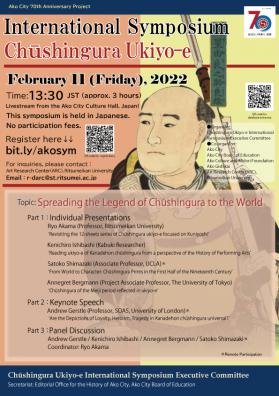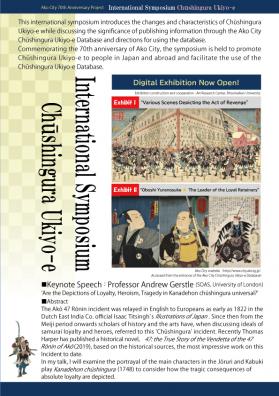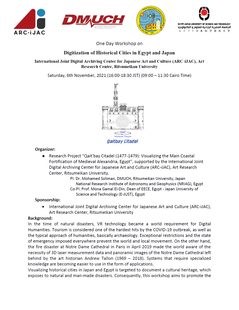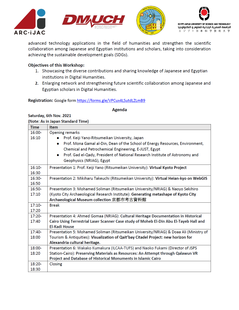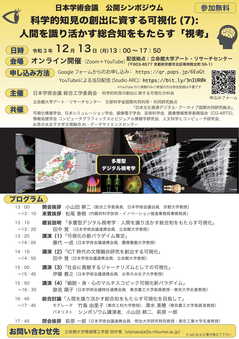-
 15
16
17
18
19
20
21
22
23
24
25
15
16
17
18
19
20
21
22
23
24
25

The Art Research Center (ARC) is pleased to announce the Chūshingura Ukiyo-e International Symposium. (*This event is held in Japanese)
Date: February 11 (Friday), 2022
Time: 13:30 Japan Standard Time (approx. 3 hours)
Topic: Spreading the Legend of Chūshingura to the World
Read more>>[イベント情報]February 2, 2022(Wed)The 98th International ARC Seminar, held on January 19, 2022, is now available on YouTube.
The program was as follows:
Topic: Tracing the Roots of Popular Music in Kyoto - BAN HIROSHI University in Ritsumeikan University -
Speaker: Ban Hiroshi (Musician /Rock 'n' Roller)
Saito Shinya (Associate Professor, Ritsumeikan University)
Takeda Shosaku (Professor, Ritsumeikan UniversityWe hope you enjoy the video!
[イベント情報]January 24, 2022(Mon)Background:
Dr. Ryoko Matsuba, a specialist in Edo period print culture, received her Ph.D. from Ritsumeikan University in 2008. She is now Lecturer in Japanese Digital Arts and Humanities at the Sainsbury Institute for the Study of Japanese Arts and Cultures (SISJAC), University of East Anglia. Before taking up that post, she participated, as a member of curatorial staff, in two major exhibitions at the British Museum: Hokusai Beyond the Great Wave (2017); and the Citi Exhibition Manga (2019). She co-authored the exhibition catalogue for the latter.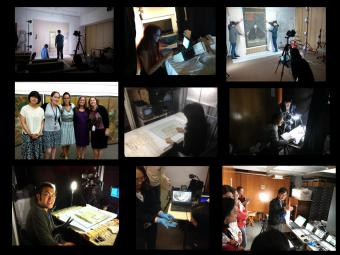 Matsuba sensei, thank you very much for joining us today. Would you tell us about your time at the ARC?
Matsuba sensei, thank you very much for joining us today. Would you tell us about your time at the ARC?Dr. Matsuba: When the Art Research Center was established, I was an undergraduate student at Ritsumeikan University. I joined the digital-archiving project led by Professor Akama as a part timer involved digitizing kabuki playbills from Osaka and Edo dating from the 18th and 19th centuries.
I gradually came to grasp the techniques and basic procedures of digital archiving, such as scanning photographs, cataloging, and improving the searchability of items, while I worked through the kabuki playbills. This experience laid the foundation for my M.A. and Ph.D. research topics. So, I treasure my time at the ARC very much.
We are glad to hear this. How did it come about that you started to work in the UK?
Dr. Matsuba: When I was still a graduate student, the ARC first provided me with the opportunity to travel to the UK and work at the British Museum as part of the team preparing the exhibition Kabuki Heroes on the Osaka Stage 1780-1830 (2005).
The ARC has been digitizing Japanese collections in renowned museums around the world, and supporting them in creating exhibitions. These activities offer many hands-on training and networking opportunities for young researchers.
Subsequently, I participated in the preparation other British Museum exhibitions such as Shunga: Sex and Pleasure in Japanese Art (2013); Hokusai: Beyond the Great Wave (2017); and the Citi Exhibition Manga (2019). In addition, I contributed to and assisted in editing the exhibition catalogs for those exhibitions.
Read more>>On January 19, 2022, the Heian-kyo Site Database--a project led by Prof. Keiji Yano (Deputy Director of the Art Research Center)--was featured in the NHK program 'まちに残る"平安京"を探せ!'.
Read more about the Heian-kyo Site Database:
https://www.arc.ritsumei.ac.jp/e/news/pc/012622.htmlWatch the video on the NHK website:
https://www.nhk.or.jp/kyoto-blog/chiebukuro/[イベント情報]January 7, 2022(Fri)The application for FY 2022 International Joint Research with Research Fund is open until February 3 (Thurs), 2022, 10AM (JST). Successful projects will receive research funds from the ARC-iJAC.
Learn more about the application here.
Read more>>[イベント情報]December 24, 2021(Fri)JAPAN SEARCH has launched an online gallery and two accompanying promotional videos about the world of kabuki based on the virtual exhibition The Most Curiosity Kabuki World of the Art Research Center (ARC), Ritsumeikan University.
>>JAPAN SEARCH Online Gallery 'The Most Curiosity Kabuki World'
>>ARC Virtual Exhibition 'The Most Curiosity Kabuki World'
〇 PV The Most Curiosity Kabuki World (Part 1)
〇 PV The Most Curiosity Kabuki World (Part 2)
[イベント情報]December 21, 2021(Tue)The video of the one-day workshop Digitization of Historical Cities in Egypt and Japan, held on November 6, 2021, as part of the FY 2021 ARC-iJAC project Qait'bay Citadel (1477-1479): Visualizing the Main Coastal Fortification of Medieval Alexandria, Egypt (PI: Dr. Mohamed Soliman), is now available on YouTube.
*Please scroll down for more information regarding the workshop.
We kindly invite you to join the one-day workshop Digitization of Historical Cities in Egypt and Japan.
Date: Saturday, November 6, 2021 16:00-18:30 JST (09:00 - 11:30 Cairo Time)
Organizer: Research Project Qait'bay Citadel (1477-1479): Visualizing the Main Coastal Fortification of Medieval Alexandria, Egypt, supported by the International Joint Digital Archiving Center for Japanese Art and Culture (ARC-iJAC), Art Research Center, Ritsumeikan University.
PI: Dr. Mohamed Soliman, DMUCH, Ritsumeikan University, Japan / National Research Institute of Astronomy and Geophysics (NRIAG), Egypt
Co-PI: Prof. Mona Gamal El-Din, Dean of EECE, Egypt - Japan University of Science and Technology (E-JUST), Egypt
Sponsorship: International Joint Digital Archiving Center for Japanese Art and Culture (ARC-iJAC), Art Research Center, Ritsumeikan University
Registration: <Registration closed>
Background: In the time of natural disasters, VR technology became a world requirement for Digital Humanities. Tourism is considered one of the hardest hits by the COVID-19 outbreak, as well as the typical approach of humanities, basically archaeology. Exceptional restrictions and the state of emergency imposed everywhere prevent the world and local movement. On the other hand, the fire disaster at Notre Dame Cathedral in Paris in April 2019 made the world aware of the necessity of 3D laser measurement data and panoramic images of the Notre Dame Cathedral left behind by the art historian Andrew Tallon (1969 - 2018). Systems that require specialized knowledge are becoming easier to use in the form of applications.
Visualizing historical cities in Japan and Egypt is targeted to document a cultural heritage, which exposes to natural and man-made disasters. Consequently, this workshop aims to promote the advanced technology applications in the field of humanities and strengthen the scientific collaboration among Japanese and Egyptian institutions and scholars, taking into consideration achieving the sustainable development goals (SDGs).
Objectives of this workshop: (1) Showcasing the diverse contributions and sharing knowledge of Japanese and Egyptian institutions in Digital Humanities. (2) Enlarging network and strengthening future scientific collaboration among Japanese and Egyptian scholars in Digital Humanities.
Agenda
Saturday, November 6, 2021
(Note: As in Japan Standard Time)
Time Item 16:00-
16:10Opening remarks
● Prof. Keiji Yano-Ritsumeikan University, Japan
● Prof. Mona Gamal al-Din, Dean of the School of Energy Resources, Environment, Chemical and Petrochemical Engineering, E-JUST, Egypt
● Prof. Gad el-Qady, President of National Research Institute of Astronomy and Geophysics (NRIAG), Egypt
16:10-
16:30Presentation 1: Prof. Keiji Yano (Ritsumeikan University): Virtual Kyoto Project 16:30-
16:50Presentation 2: Mikiharu Takeuchi (Ritsumeikan University): Virtual Heian-kyo on WebGIS 16:50-
17:10Presentation 3: Mohamed Soliman (Ritsumeikan University/NRIAG) & Naoyo Sekihiro (Kyoto City Archaeological Research Institute): Generating metashape of Kyoto City Archaeological Museum collection 京都市考古資料館 17:10- 17:20 Break 17:20-17:40 Presentation 4: Ahmed Gomaa (NRIAG): Cultural Heritage Documentation in Historical Cairo Using Terrestrial Laser Scanner Case study of Moheb El-Din Abu El-Tayeb Hall and El-Kadi House 17:40-18:00 Presentation 5: Mohamed Soliman (Ritsumeikan University/NRIAG) & Doaa Ali (Ministry of Tourism & Antiquities): Visualization of Qait'bay Citadel Project: new horizon for Alexandria cultural heritage. 18:00-18:20 Presentation 6: Wakako Kumakura (ILCAA-TUFS) and Naoko Fukami (Director of JSPS Station-Cairo): Preserving Materials as Resources: An Attempt through Qalawun VR Project and Database of Historical Monuments in Islamic Cairo 18:20-18:30 Closing [イベント情報]December 20, 2021(Mon)The video of the symposium Scientific Knowledge Generation facilitated by Visualization (7): 'Visual Thinking' that brings a Comprehensive Knowledge of Humanity to Life, organized by the Science Council of Japan in cooperation with the International Joint Digital Archiving Center for Japanese Art and Culture (ARC-iJAC), Art Research Center, is now available on YouTube.
Public Online Symposium (*held in Japanese)
The Science Council of Japan Presents:
Scientific Knowledge Generation facilitated by Visualization (7): 'Visual Thinking' that brings a Comprehensive Knowledge of Humanity to Life
<<Registration closed >>
Date: December 13 (Monday), 2021 13:00-17:50 (Japan Standard Time)
Organizer: Subcommittee for Scientific Knowledge Generation facilitated by Visualization, General Engineering Committee, Science Council of Japan
Co-Organizer: International Joint Digital Archiving Center for Japanese Art and Culture (ARC-iJAC), Art Research Center, Ritsumeikan University
Visualization Society of Japan
Japan Society for Simulation Technology
The Institute of Image Electronics Engineers of Japan
The Society for Art & Science
Computer Graphic Arts Society
Computer Graphics and Visual Informatics, Information Processing Society of Japan
IPSJ SIG Computers and the Humanities
Center for Interdisciplinary AI and Data Science, Ochanomizu University
Participation: Via Zoom (free of charge)
<<Register here: https://qr.paps.jp/6EaGt>>
(Note: The symposium will be recorded and available on the ARC YouTube Channel https://bit.ly/3nIUR0k.)
Purpose of the Event: We are entering an era in which a wide variety of Big Data generated every day has an enormous impact on science, society, culture, education, the human body and mind. The effects are highly complex and diverse.
For this reason, 'visualization' that supports the effective use of a wide variety of Big Data in an integrated manner to obtain comprehensive knowledge is required. Through such visualization, our thinking will be accelerated and deepened into 'Visual Thinking'.
This symposium, the seventh in the series, is a comprehensive report on the ongoing discussion of the ways of visualization in the era of Big Data and has been held for three and a half years since the 'Visualization Subcommittee for Contributing to the Generation of Scientific Knowledge' was established at the Science Council of Japan. At the same time, it is an opportunity to discuss various ideas about visualization in the future.
Program: https://www.scj.go.jp/ja/event/2021/317-s-1213.html (in Japanese)
For inquiries, please contact Satoshi Tanaka (Professor, College of Information Science and Engineering, Ritsumeikan University). E-mail: stanaka*is.ritsumei.ac.jp (please replace * with @).
[イベント情報][Event Information] ARC organizes Ritsumeikan University Saturday Seminars (3349th & 3350th session)December 15, 2021(Wed)
The Art Research Center (ARC) is pleased to inform that we are organizing two sessions of the Ritsumeikan University Saturday Seminars, a public lecture series by Ritsumeikan University. Participation is free of charge.
1. Ritsumeikan University Special Saturday Lecture (3349th session) >> Click here to register<<
Date and Time: January 22 (Sat), 2022 13:00 - 14:30 (JST)
Speaker: Hirotaka Sato (Assistant Professor, College of Letters, Ritsumeikan University)
Topic: デジタル・アーカイブによる地域文化資源の発見と活用 (→ Synopsis)
2. Ritsumeikan University Special Saturday Lecture (3350th session) >> Click here to register<<
Date and Time: January 29 (Sat), 2022 13:00 - 15:00 (JST)
1. Speaker: Rika Yamamoto (Associate Professor, College of Letters, Ritsumeikan University)
Topic: ツーリズムが求める産業遺産の歴史性とデジタルテクノロジー (→ Synopsis)
2. Speaker: Nozomu Ataka (Research Assistant, International Joint Digital Archiving Center for Japanese Art and Culture (ARC-iJAC), Art Research Center, Ritsumeikan University)
Topic: 文化資源から見たツーリズム 〜小型案内記・絵図から見た江戸時代の奈良半日観光 (→ Synopsis)
Commentators:
Yukio Teratoko (Associate Professor, College of Letters, Ritsumeikan University)
Yuji Miyata (Research Assistant, International Joint Digital Archiving Center for Japanese Art and Culture (ARC-iJAC), Art Research Center, Ritsumeikan University)
**Jointly organized with the Institute of Humanities, Human and Social Sciences, Ritsumeikan University.
Participation: Online via Zoom (free of charge)
Registration: Advance registration is required (limited capacity of 400)
Please refer to the website of the Ritsumeikan University Saturday Seminar Series for details (in Japanese).
**Please note that these lectures will be held in Japanese.
 15
16
17
18
19
20
21
22
23
24
25
15
16
17
18
19
20
21
22
23
24
25



